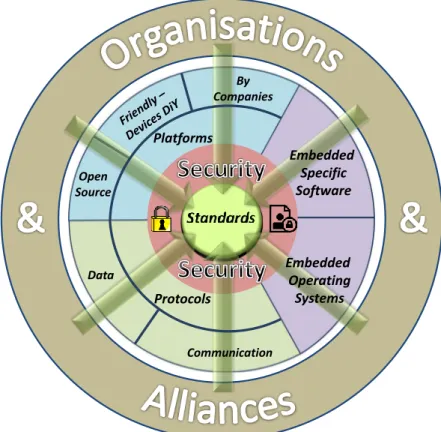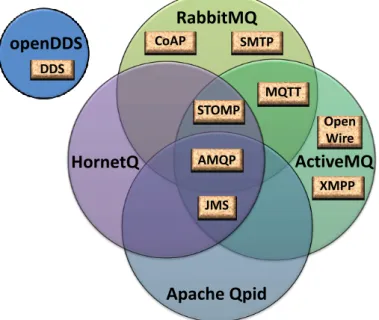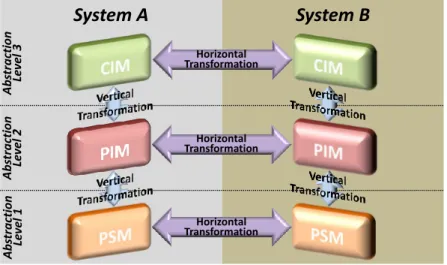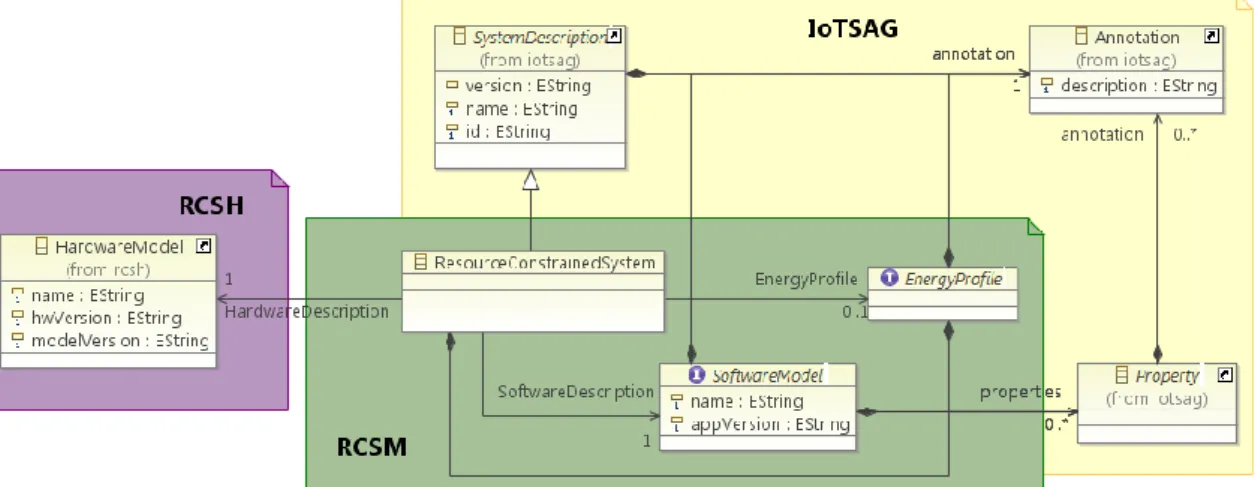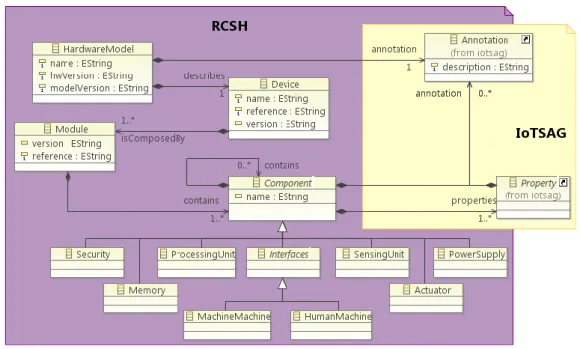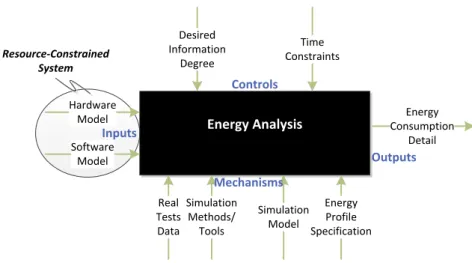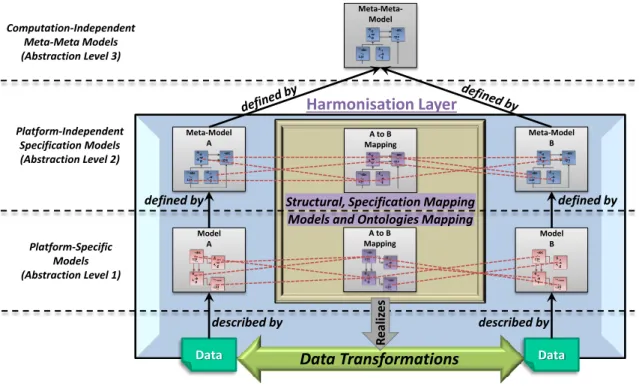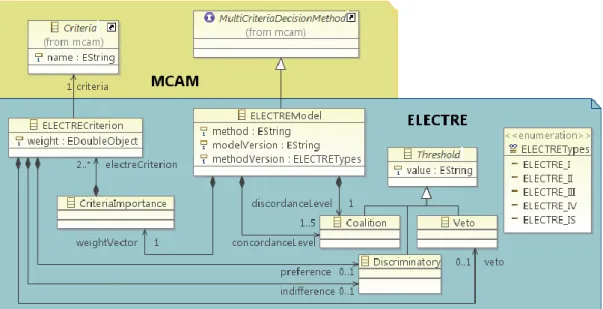Mestre em Engenharia Electrotécnica e de Computadores
A Multi-Criteria Framework to Assist on the
Design of Internet-of-Things Systems
Dissertação para obtenção do Grau de Doutor em Engenharia Electrotécnica e de Computadores
Orientador: Ricardo Luís Rosa Jardim Gonçalves, Professor Cate-drático, Faculdade de Ciências e Tecnologia da Univer-sidade Nova de Lisboa
Júri
Presidente: Prof. Doutor João Carlos da Palma Goes
Arguentes: Prof. Doutor Ioan-Stefan Sacala
Prof. Doutora Teresa Cristina de Freitas Gonçalves
Vogais: Prof. Doutor Ricardo Luís Rosa Jardim Gonçalves
Prof. Doutor João Francisco Alves Martins Prof. Doutor Manuel Martins Barata
Prof. Doutor João Pedro Mendonça de Assunção da Silva Prof. Doutor Carlos Manuel Melo Agostinho
tems
Copyright © Edgar Miguel Felício Oliveira da Silva, Faculdade de Ciências e Tecnologia, Universidade NOVA de Lisboa.
A Faculdade de Ciências e Tecnologia e a Universidade NOVA de Lisboa têm o direito, perpétuo e sem limites geográficos, de arquivar e publicar esta dissertação através de exemplares impressos reproduzidos em papel ou de forma digital, ou por qualquer outro meio conhecido ou que venha a ser inventado, e de a divulgar através de repositórios científicos e de admitir a sua cópia e distribuição com objetivos educacionais ou de inves-tigação, não comerciais, desde que seja dado crédito ao autor e editor.
First of all I have to thank all my Family, especially to my uncles Carlos and Maria Jóse Felício, for the unending support, strength in the most difficult times, and for never ever had doubted that I could successfully accomplish this work.
I want to thank my supervisor, Professor Ricardo Jardim Gonçalves, for the opportu-nity he gave me, to work with him and join his research team. With a constant support, believing in skills and let me freely explore it accordingly with my motivations and in-stincts.
A special acknowledgement to Manuela Fernandes, for her knowledge and experi-ence to this work, motivation, comments and questions have encouraged, supported and enlightened me to do a better work. Also a special acknowledgement to João, Ricardo, Maria, Paulo and more recently Vanessa for their support and companionship. I wish to acknowledge Fábio Oliveira, Luís Paiva and João Eusébio for their support.
A special thank goes also for the master students to whom I collaborated or had the pleasure of co-supervising, namely João Rodrigues, José Gonçalves, Fernando Rosado, João Ralo and Igor Fernandes.
Then, I would like to thank my colleagues at Group for Research in Interoperability of Systems (GRIS) and Energy Efficiency Research Group for their advices, encouragement and productive discussions that really contributed to this research work.
Finally, my great thanks to Faculdade de Ciências e Tecnologia da Universidade Nova de Lisboa (FCT NOVA) and to Instituto de Desenvolvimento de Novas Tecnologias (UNI-NOVA) for hosting this research.
The Internet-of-Things (IoT), considered as Internet first real evolution, has become immensely important to society due to revolutionary business models with the potential to radically improve Human life. Manufacturers are engaged in developing embedded systems (IoT Systems) for different purposes to address this new variety of application domains and services. With the capability to agilely respond to a very dynamic market offer of IoT Systems, the design phase of IoT ecosystems can be enhanced. However, select the more suitable IoT System for a certain task is currently based on stakeholder’s knowledge, normally from lived experience or intuition, although it does not mean that a proper decision is being made. Furthermore, the lack of methods to formally describe IoT Systems characteristics, capable of being automatically used by methods is also an issue, reinforced by the growth of available information directly connected to Internet spread.
Contributing to improve IoT Ecosystems design phase, this PhD work proposes a framework capable of fully characterise an IoT System and assist stakeholder’s on the de-cision of which is the proper IoT System for a specific task. This enables dede-cision-makers to perform a better reasoning and more aware analysis of diverse and very often contra-dicting criteria. It is also intended to provide methods to integrate energy consumption-simulation tools and address interoperability with standards, methods or systems within the IoT scope. This is addressed using a model-driven based framework supporting a high openness level to use different software languages and decision methods, but also for interoperability with other systems, tools and methods.
Keywords: Internet-of-Things, Resource-Constrained Systems, Model-Driven Engineer-ing, Interoperability, Multi-Criteria Decision, IoT Systems Assessment.
A Internet das Coisas (IdC), considerada a primeira evolução real da Internet, tornou-se imensamente importante para a sociedade devido a modelos de negócios revolucio-nários com o potencial de melhorar radicalmente a vida humana. Os fabricantes estão focados no desenvolvimento de sistemas embutidos (Sistemas IdC) para diversas finali-dades, de modo a responder à nova variedade de aplicações para diferentes domínios e serviços. Com a ágil capacidade para responder a um mercado muito dinâmico na oferta de Sistemas IdC, a fase de desenvolvimento dos ecossistemas da IdC pode ser melhorado. No entanto, a escolha do Sistema IdC mais adequado para uma determinada tarefa ac-tualmente é assenta no conhecimento das partes envolvidas, normalmente baseada na experiência ou na intuição, embora não signifique que a decisão mais adequada esteja a ser realizada. Além disso, a falta de métodos para descrever formalmente as característi-cas dos Sistema IdC, capazes de serem usados automaticamente por sistemas, também é um problema, reforçado pelo constante crescimento de informações disponíveis, directa-mente ligado à propagação pela Internet.
Contribuindo para melhorar a fase de projecto dos ecossistemas da IdC, este trabalho de doutoramento propõe uma estrutura capaz de caracterizar completamente um Sistema IdC e auxiliar as partes interessadas na decisão sobre qual é o Sistema IdC mais adequado para uma tarefa específica. Isto permite que os responsáveis pela decisão executem um melhor raciocínio e uma análise mais consciente dos diversos critérios e muitas vezes con-traditórios. Também se destina a fornecer métodos para a integração de ferramentas de simulação do consumo de energia, tal como para estabelecer interoperabilidade com pa-drões, métodos ou sistemas no âmbito da IdC. Isto será conseguido usando umaframework baseada em modelos fornecendo um grande nível de abertura para o uso de diferentes linguagens de programação e métodos de decisão, mas também para a interoperabilidade com outros sistemas, ferramentas e métodos.
Palavras-chave: Internet das Coisas, Sistemas de Recursos Limitados, Engenharia Ori-entada a Modelos, Interoperabilidade, Decisão Multicritério, Avaliação de Sistemas da Internet das Coisas.
List of Figures xvii
List of Tables xxi
Glossary xxiii
Acronyms xxv
1 Introduction 1
1.1 Motivation . . . 2
1.2 Vision and Research Approach. . . 3
1.3 Adopted Research Method . . . 4
1.4 Research Problem and Hypothesis. . . 7
1.4.1 Research Question . . . 7
1.4.2 Hypothesis . . . 8
1.5 Thesis Plan Outline . . . 8
1.5.1 Core Block I: Introduction . . . 9
1.5.2 Core Block II: Background . . . 9
1.5.3 Core Block III: Contributions . . . 10
1.5.4 Core Block IV: Validation . . . 11
1.5.5 Core Block V: Conclusions . . . 11
2 Internet-of-Things (IoT) 13 2.1 Challenges, Barriers and Trends . . . 14
2.2 Wireless Sensor Networks . . . 15
2.2.1 WSN Specific Issues. . . 16
2.2.2 Resource-Constrained Systems (RCS). . . 17
2.3 Standards . . . 19
2.3.1 Organisations & Alliances . . . 20
2.3.2 Protocols . . . 22
2.3.3 Platforms. . . 31
2.3.4 Embedded Operating Systems (OS) . . . 34
2.4 Topic Discussion . . . 40
3 Model-Driven Approaches 43 3.1 A First Attempt: Computer-Aided Software Engineering . . . 43
3.1.1 CASE Risk Factors. . . 44
3.2 Model-Driven Engineering . . . 44
3.2.1 Models and Meta-Models . . . 45
3.2.2 Model-Driven Architecture . . . 47
3.2.3 MDA Models and Viewpoints . . . 47
3.2.4 MDA and Model Transformations . . . 49
3.2.5 Horizontal and Vertical Transformations . . . 49
3.3 Modelling and Transformation Languages . . . 50
3.3.1 Modelling Languages . . . 51
3.3.2 Transformation Languages . . . 53
3.4 Topic Discussion . . . 55
4 Decision-Making Methodologies 57 4.1 Decision-Making Process . . . 58
4.2 Methods for Multi-Criteria Decision-Making . . . 59
4.2.1 Analytic Hierarchy Process (AHP) . . . 59
4.2.2 PROMETHEE . . . 62
4.2.3 ELECTRE . . . 64
4.3 Topic Discussion . . . 65
5 Framework to Formally Describe an IoT System 69 5.1 Models, Methods for IoT Systems Specification . . . 69
5.1.1 Hardware Representations . . . 70
5.2 Framework for IoT System Formal Description . . . 71
5.3 Specification of IoT System Generic Features. . . 73
5.4 IoT System Specification . . . 75
5.4.1 IoT System: Hardware Specification . . . 76
5.4.2 IoT System: Software Formalisation . . . 80
5.4.3 IoT System: Energy Profile Formalisation . . . 82
5.5 Model-Driven Harmonisation Framework . . . 86
5.6 Topic Discussion . . . 89
6 Assessment Framework for IoT Systems 91 6.1 Decision-Making in IoT . . . 91
6.2 Framework for IoT Systems Assessment . . . 92
6.3 Multi-Criteria Assessment Specification . . . 95
6.4 MCDM Methods Specification . . . 98
6.4.2 ELECTRE Specification . . . 101
6.5 IoT Systems: Multi-Criteria Assessment Methodology . . . 102
6.6 Topic Discussion . . . 108
7 Framework for Design Support of IoT Systems 111 7.1 Conceptual Approach for Design Support of IoT Systems . . . 111
7.2 Framework for Design Support of IoT Systems . . . 113
7.3 Design of IoT Systems: Specification Models . . . 116
7.4 Harmonisation Layer & Interoperability Engine . . . 120
7.5 Topic Discussion . . . 124
8 Implementation and Hypothesis Validation 127 8.1 Proof-of-Concept Implementations . . . 127
8.1.1 Application Scenario 1: Smart Building Design . . . 128
8.1.2 Application Scenario 2: SensorML Standard . . . 134
8.2 Technical Implementations . . . 136
8.2.1 Implementation of Scenario 1: Smart Building Design . . . 136
8.2.2 Implementation of Scenario 2: SensorML Standard . . . 146
8.3 Acceptance by Scientific Community & Industry . . . 148
8.3.1 Acceptance by Scientific Community . . . 148
8.3.2 Acceptance by Industry . . . 150
8.4 Hypothesis Validation. . . 161
9 Conclusions 163 9.1 The Path from Background Research up to PhD Thesis . . . 163
9.1.1 Background Observation . . . 164
9.1.2 Research Work. . . 166
9.2 Scientific and Technical Contributions . . . 168
9.2.1 From a Research Question to Validation . . . 168
9.2.2 Publications Summary . . . 169
9.3 Future Work . . . 171
Bibliography 173
A Appendix: IoTSAG Ecore Representation 195
B Appendix: RCSM Ecore Representation 199
C Appendix: RCSH Ecore Representation 201
D Appendix: MCAM Ecore Representation 205
F Appendix: ELECTRE Ecore Representation 211
G Appendix: IoTSAC Ecore Representation 213
H Appendix: C Language Ecore Representation 215
I Appendix: nesC Language Ecore Representation 219
1.1 Research Approach: The Path to Select a More Suitable IoT System. . . 3
1.2 Adopted Research Method. . . 5
1.3 Research Question and Hypothesis. . . 9
1.4 Thesis Plan Outline . . . 10
2.1 Overview of an Internet-of-Things (IoT) Ecosystem. . . 14
2.2 Example of a Wireless Sensor Network (WSN). . . 16
2.3 Typical Sensor Node Architecture.. . . 18
2.4 IoT Standardisation. . . 19
2.5 IoT Protocols: Radio Frequency and Network Areas. . . 23
2.6 Connectivity Space of MOM Protocols. . . 29
2.7 MOM Protocols vs Open Source Message Brokers.. . . 30
2.8 Articles Percentage related to each Operating System. . . 37
3.1 MDA, MDD and MDE initiatives. . . 45
3.2 Model and Meta-Models Relationship. . . 46
3.3 MDA’s Abstraction Layers (viewpoints). . . 48
3.4 MDA’s Abstraction Layers and Transformations. . . 50
3.5 Relations between QVT Meta-Models (based on [173]). . . 54
3.6 A Generic ATL Transformation. . . 55
4.1 Simplified Vision of Decision-Making Process. . . 58
4.2 Analytic Hierarchy Process (AHP) original Methodology.. . . 60
4.3 Example of a criteria and solutions hierarchy. . . 60
4.4 PROMETHEE Methodology. . . 62
4.5 PROMETHEE: Example of an Outranking Valued Digraph. . . 64
5.1 Hardware Components of a Sensor Node. . . 71
5.2 A Framework to Formally Describe an IoT System. . . 73
5.3 IoT Systems Analysis Generic (IoTSAG) Specification Model. . . 74
5.4 Property Domains and Units Relation: Graphical Example. . . 74
5.5 Resource-Constrained System (RCS) Specification Model. . . 75
5.7 Resource-Constrained System Hardware (RCSH) Specification Model. . . 78
5.8 Hardware Platform: A RCSH Formal Representation Example. . . 80
5.9 Software Language Specification: A Generic Example. . . 81
5.10 IoT System’ Energy Consumption Analysis Activity Detail. . . 83
5.11 Energy Profile Specification: An Example. . . 84
5.12 Energy Profile: A Practical Example. . . 85
5.13 IoT System: Model and Meta-Models Relationship. . . 86
5.14 Model-Driven Harmonisation Framework. . . 87
5.15 Harmonisation Layer: Mapping Examples. . . 88
6.1 A Framework for IoT Systems Assessment. . . 93
6.2 Multi-Criteria Analysis Specification Model. . . 95
6.3 Analytic Hierarchy Process (AHP) Meta-Model. . . 99
6.4 AHP Meta-Model: Example of a Pairwise Comparison Matrix.. . . 100
6.5 Elimination and Choice Expressing the Reality (ELECTRE) Meta-Model. . . 102
6.6 Procedure to Process Assessment Constraints. . . 105
6.7 MCDM Method Procedure Activity Detail. . . 106
7.1 Proposed Concept for the Design Support of IoT Systems. . . 112
7.2 Multi-Criteria Framework for Design Support of IoT Systems.. . . 114
7.3 IoT Systems Assessment Core Specification Model. . . 117
7.4 Design Support of IoT Systems: High Level Packages Structure. . . 118
7.5 Design Support of IoT Systems: Main Specification Models. . . 119
7.6 Harmonisation Layer & Interoperability Engine: Merge/Transformation Ex-amples. . . 121
7.7 Harmonisation Layer & Interoperability Engine: Interoperability with Stan-dards. . . 123
7.8 Harmonisation Layer & Interoperability Engine: Integration of Energy Simu-lations. . . 124
8.1 Design Support of IoT Systems: Proof-of-Concept Application Scenario(s). . 128
8.2 Proof-of-Concept Scenario 1: Smart Building Design. . . 129
8.3 From Scattered Hardware to Formal IoT Systems Specification (Hardware). . 131
8.4 C Language Specification Model (version C1.0 adapted from [208].) . . . 132
8.5 nesC Specification Model (adapted from [209]). . . 133
8.6 IoT Systems Assessment: Two Objectives of Smart Building Design Scenario. 134 8.7 SensorML Main Internal Packages Dependencies (retrieved from [21]).. . . . 135
8.8 Proof-of-Concept Scenario 2: Temperature Sensor with Online Data Observa-tion (SensorML Example). . . 136
8.9 IoT Systems Formal Descriptions Based on Web-Pages Information. . . 138
8.11 Harmonisation Layer: From Software Languages Specification to Applications
Code (Text Files). . . 140
8.12 From nesC Models to Application Code (Text Files). . . 142
8.13 MCAM Specification Model: Instantiation of Objective 1 — Power-Saving Through Light-Control. . . 143
8.14 MCAM Specification Model: Instantiation of Objective 2 — HVAC Control Using Motion Sensors. . . 144
8.15 MCAM Methods: Instantiation for both Objectives. . . 145
8.16 Harmonisation Layer: From Proposed Specifications to SensorML Specifica-tion (Internet of Things — Simple Sensor). . . 147
8.17 Acceptance by Scientific Community: Publications Timeline. . . 149
8.18 Industrial Scenario: C2Net’s Metalworking Process Design. . . 151
8.19 Industrial Scenario: Considered IoT Systems (Hardware part). . . 155
8.20 Industrial Scenario: Criteria Values (Radar Chart). . . 156
8.21 High-Level View of vf-OS Architecture (retrieved from [217]). . . 160
2.1 IoT Protocols: Transmission Rate. . . 25
2.2 Message-Oriented Middleware (MOM) Protocols Summary. . . 28
2.3 Summary of WSN OSs Features. . . 38
2.4 List of supported Hardware platforms. . . 39
4.1 Random Consistency Index values, RI, from 2 to 10 criteria. . . . 61
4.2 AHP, PROMETHEE and ELECTRE: Main Advantages and Disadvantages. . . 66
8.1 Harmonisation Layer: Structural, Specification Mapping to SensorML (Inter-net of Things — Simple Sensor). . . 148
8.2 C2Net Scenario: Criteria Preference Relation. . . 153
8.3 C2Net Scenario: Criteria Values. . . 155
8.4 C2Net Scenario: Conversion of criterion “Implementation Difficulty”. . . 157
8.5 C2Net Scenario: IoT Systems Final Ordered Ranking. . . 159
9.1 Relation Between Research Sub-Questions and Contributions. . . 169
9.2 Accomplished Publications in Conferences. . . 170
Internet-of-Things Internet-of-Things is a worldwide network of physical objects using the Internet as a communication media. Interconnected objects, services, people, and devices that can communicate, share data, and information to achieve common goals in different areas and applications.
IoT Ecosystem IoT Ecosystem is based on an Internet-of-Things network with sensors and actuators, providing services such as data storage, analysis, using IoTcloud services built upon IoT cloud platforms, within a diverse context of application scenarios (e.g.: Smart Cities, Intelligent Transportation Systems, Domotics (Smart Buildings), Industry 4.0, among others).
IoT System IoT System defines a “thing”, a device executing a task for the Internet-of-Things (IoT), as a whole. It is considered that an IoTSystem is composed by two core parts and a third one if available. The two core parts are the hardware components and the software (Operating System (OS)and application). The third part is an energy profile, built upon, from the two mandatoryIoTSystem parts. An
IoTSystem is by its nature aResource-Constrained System (RCS).
Resource-Constrained Systems Resource-Constrained System is a device that has small size, low-power operations, limited processing and storage capabilities, and that often runs on batteries. They also present other particular features such sensing the environment and wireless communication.
System Accordingly to online dictionaries and author point of view, a system can be defined as a “group of items forming a unified whole”[1], “a set of connected things or devices that operate together”, or “a set of computer equipment and programs used together for a particular purpose”[2].
ADC Analog-to-Digital Converter. AHP Analytic Hierarchy Process.
AMQP Advanced Message Queuing Protocol. API Application Programming Interface. ATL Atlas Transformation Language. AWS Amazon Web Services.
CASE Computer-Aided Software Engineering. CIM Computation Independent Model. CoAP Constrained Application Protocol. CPS Cyber-Physical System.
DDS Data Distribution Service. DiY Do it yourself.
ELECTRE Elimination and Choice Expressing the Reality. EMF Eclipse Modeling Framework.
ETSI European Telecommunications Standards Institute.
GPS Global Positioning System.
HTML Hypertext Markup Language. HTTP Hypertext Transfer Protocol.
HTTPS Hypertext Transfer Protocol Secure.
IEC International Electrotechnical Commission. IEEE Institute of Electrical and Electronics Engineers. IETF Internet Engineering Task Force.
IoT Internet-of-Things.
IoTSAC IoT Systems Assessment Core. IoTSAG IoT Systems Analysis Generic. ISA International Society of Automation. ISM Industrial, Scientific, and Medical.
ISO International Organization for Standardization. IT Information Technology.
ITU International Telecommunication Union.
ITU-T ITU Telecommunication Standardization Sector.
JMS Java Message Service. LoRa Long-Range.
LTE Long-Term Evolution. M2M Machine-to-Machine.
MCAM Multi-Criteria Analysis Meta-Model. MCDM Multi-Criteria Decision-Making. MDA Model-Driven Architecture. MDD Model-Driven Development. MDE Model-Driven Engineering.
MEMS Micro-Electro Mechanical System. MOF Meta-Object Facility.
MOM Message-Oriented Middleware.
MQTT Message Queuing Telemetry Transport. NB-IoT Narrowband IoT.
nesC Network Embedded Systems C. NFC Near-field communication.
OASIS Organization for the Advancement of Structured Information Standards. OGC Open Geospatial Consortium.
OMG Object Management Group. OS Operating System.
OSS Open-Source Software. PIM Platform Independent Model. POC Proof-of-Concept.
PROMETHEE Preference Ranking Organization Method for Enrichment Evaluation. PSM Platform Specific Model.
PtoP Point-to-Point. QoS Quality-of-Service.
QVT Query/Views/Transformations. RAM Random-Access Memory. RCS Resource-Constrained System.
RCSH Resource-Constrained System Hardware. RCSM Resource-Constrained System Meta-Model. REST Representational State Transfer.
RFID Radio-Frequency identification. SensorML Sensor Model Language. SMTP Simple Mail Transfer Protocol. SPI Serial Peripheral Interface.
SRAM Static Random-Access Memory. SSN Semantic Sensor Network.
SUS System Under Study.
SysML Systems Modeling Language. TCP Transmission Control Protocol.
TCP/IP Transmission Control Protocol / Internet Protocol.
UART Universal Asynchronous Receiver/Transmitter. UDP User Datagram Protocol.
UML Unified Modelling Language. USB Universal Serial Bus.
W3C World Wide Web Consortium. WLAN Wireless Local Area Network.
WMAN Wireless Metropolitan Area Network. WPAN Wireless Personal Area Network. WSN Wireless Sensor Network.
WWAN Wireless Wide Area Network. XMI XML Metadata Interchange. XML Extensible Markup Language.
C
h
a
p
t
1
I n t r o d u c t i o n
ASystemcan be defined as a “group of items forming a unified whole” [1] “set of con-nected things or devices that operate together”, or “a set of computer equipment and programs used together for a particular purpose” [2]. Consequently, anIoTdeployment is anIoTSystem, considering that each device interacting in a deployment is a thing/item, and this is the common meaning used in theIoTscope literature. Taking into considera-tion a single device, it is by its own a system, composed by different hardware components interacting among them and running one or more programs/firmware.
Hereupon, IoT complete system is referred as IoT Ecosystem, IoT Deployment or System ofIoTSystems, and anIoTdevice asIoT SystemorRCS.
TheInternet-of-Things(IoT) today is a reality. It is a highly heterogeneous environ-ment [3], composed by a vast number of “things” (devices, sensors, smart objects, etc.) and sometimes called “Internet of Objects”, which refers to uniquely identifiable objects and their representation in an Internet-like structure. Some studies, predict that there will be around 30 Billion devices wireless connected to theIoTin the next years [4, 5]. The emergingIoT-related technologies have been creating an idea of a global, dynamic network infrastructure where physical and virtual “things” communicate and share in-formation among each other. Powered by advances in microelectronic technologies, that led to smaller and cheaper devices, capable of performing major tasks than before.
However,IoT is still in an early stage and many challenging issues still need to be addressed, both at technological, as well as, at social level. With the potential to slowdown
IoTdevelopment, they need to be solved beforeIoTparadigm becomes widely accepted. For instance, from a technological point of view, questions have been raised on how to fully establish devices interoperability (adaptation and autonomous behaviour), as well as, new problems concerning network aspects (unique IP addresses, scalability, etc.). Regarding social aspects it is important to guaranty trust, privacy and security to the user.
It should be assured that personal information is used accordingly and that there is no unauthorized disclosure of information [6–9].
1.1
Motivation
The Internet-of-Things (IoT) technology is becoming more and more important to society, with diverse and novel business models giving to people a more truly interaction with the surrounding world. IoThas applicability in many areas, such as Smart Cities, Intelligent Transportation Systems, Domotics (Smart Buildings), Industry 4.0, among others [3].
These “smart systems”, i.e.: IoT deployments, IoT Ecosystems, are normally built upon devices with a very specific characteristic — Resource-Constrained. These “things”, “objects”, are devices characterised with high resources constraints mainly due to low
power, small processing and storage capabilities.
Manufacturers are engaged in developing new embedded systems for different pur-poses, addressing the variety of application domains and services. This diversity unlocks the use of a wide set of hardware platforms and software solutions (OSas implementation techniques). IoTSystems perform different tasks, such as, sensing, radio messages,
math-ematical computation, etc. each one with a distinct influence on energy consumption. Changing the device/hardware even more uncertainties arises. Not only will the energy consumption, but also with execution time as well as development time. Cost, size and weight factors will also be different when an implementation platform is change.
Consequently some scenarios can then be established: which are the more suitable devices (hardware platforms) to accomplish a certain task, or is it possible/feasible to build a new hardware through the integration of distinct components available on other devices, or which is the best way to programme the execution of a task. Researchers, domain practitioners, engineers are developing OSs to get more performance for less energy consumption. Computation requirements, flexibility, fault tolerance, high sensing fidelity, low-cost and rapid deployment are other characteristics expected when thinking in deploying IoTSystems [10–12]. Combining or fulfil several requirements is not an easy task. Applications differ from each other making the selection of a perfect solution hard to come by.
Therefore, engineers are facing a difficult task, i.e.: to choose a solution between all available ones that best fulfil their intentions. Select a solution normally involves the analyses of criteria. In this case, such criteria could be performance, storage, energy consumption, cost, size, weight, available resources, among others. The importance of a requisite/feature change from task to task. Make a correct, accurate decision depends many times on multiple criteria, which is a tough challenge for human beings [13]. Be-sides, the lack of formal descriptions to describe IoT Systems characteristics/features, capable of being used by applications in an automatic way, is also an issue. Some manu-facturers provide in their websites ways to select a product from a set of choices. Products
are displayed with some detailed (number of features), but limited to hardware charac-teristics. Interaction is completely handmade, with no way to apply user’s preferences between criteria. Information data, when possible, can be collected only by user’s action and change depending on the performed query. Two examples can be found in [14,15].
1.2
Vision and Research Approach
The research work envisions the proposal of a framework capable of fully characterise an
IoTSystem and assist stakeholder’s on the decision of which is the properIoTSystem for a specific task. The framework also intends to provide methods for energy consumption-simulation tools integration and address interoperability with standards, methods or systems within theIoTscope.
Literature has been more focus on study functional, behaviour aspects and on activ-ities, interactions within anIoTDeployment [16–18], rather than onIoTSystems itself. Stakeholders have been selecting anIoTSystem to perform a certain task based on their knowledge, normally from lived experience or intuition, although, it does not mean that a proper decision is being made. This task, selection, identification of the more suitable
IoTSystem is being somehow neglected during the design phase of anIoT Ecosystem. In a highly diversified market-offer (manufacturers are providing numerous device solutions), engineers could use a multi-criteria framework to simulate and analyse hard-ware and softhard-ware solutions for small parts of a global system. It will allowIoT-related technologies and solutions to be proven, tested before deployment into real world. That enables engineers to perform a more suitable design of theirIoTEcosystems.
Figure1.1depicts the research work approach, displaying literature themes used as groundwork and in which way these help to achieve the expected outcomes. To better understand and respond to the identified research questions (presented in Section1.4), the work research was split into three objectives: Formally describe anIoTSystem; char-acterise/analyse possibleIoTSystem solutions; and properly make a decision regarding which is the more suitable solution(s).
Multi-Criteria Decision Methods: Problem / Objective Parameterisation: Model-Driven Engineering: IoT Systems: On response to IoT System On analysis of IoT Systems Decision of
suitable IoT System(s)
Formal Description of an IoT System (Hardware, Software, Energy) Definition of Criteria, Constraints, Priorities, Decision Methods IoT Systems Multi-Criteria Assessment
First, “on response toIoTSystem”, the heterogeneity nature ofIoTdeployments is addressed. Markets are offering a wide device diversity, with a very specific characteris-tic — Resource-Constrained. Methods to formally describe these imperative pieces (IoT
Systems) are needed, independent of hardware platforms, as well as independent from programming languages — Platform Independent. In this way, Resource-Constrained Sys-tems (RCS) should be study carefully andModel-Driven Engineering (MDE)techniques study and applied, since model driven approaches revealed to be a common ground in literature [19–23].
Second, “on analysis ofIoTSystems”, addresses the characterisation of the problem that needs to be solved. As a result from the previous point, IoTSystems features are formally defined, allowing a smooth integration with other systems/tools. The prob-lem parameterisation consists on defining the objective, criteria, constraints, etc. Once more,MDEgains here an important role.MDEtackles systems complexity through sim-plification and formalisation techniques during system life cycle (i.e. from design to deployment, passing by construction, operation, modification, etc.) [23], and facilitates the interoperability among tools.
Third point addresses the “decision of suitableIoTSystem(s)”. Thematic studied focus on Multi-Criteria Decision-Making (MCDM), one of the most widely used deci-sion methodologies in sciences, business, governmental and engineering worlds.MCDM
methods improve decisions quality, by making the decision-making process more explicit, rational, and efficient [24,25].
1.3
Adopted Research Method
Merriam-Webster dictionary [26] defines the scientific method as “the principles and pro-cedures for the systematic pursuit of knowledge involving the recognition and formulation of a problem, the collection of data through observation and experiment, and the formulation and testing of hypotheses”. Scientists use the scientific method as a logical scheme to search answers to questions posed within science. Being able to yield scientific theories, includ-ing both scientific meta-theories (theories about theories), as well as, the theories used to design tools for producing theories (instruments, algorithms, etc.) [27].
There are more than one recognise scientific method. There is no universal, no formal “scientific method” to follow, each one has its own variants. The process of investigation is often referred in many textbooks and science courses, as a linear set of steps through which a scientist moves from observation through experimentation to a conclusion. It is important that researchers keep in mind that a new piece of information (i.e. idea, test results, etc.), might cause a scientist to rethink the investigation process and repeat steps at any point. Also, it is not always required to start with a question, and sometimes it is not needed to have experiments. Instead, the scientific method is a more dynamic and robust process [28,29].
The choice of which research method (instantiation of the scientific method) to use is personal and depends on the scientist and the nature of the question addressed. It is also important to choose a research method which is within the limits of time, money, feasibility, ethics and the availability of the chosen scientific measurements to get a correct conclusion [30]. To address this PhD work, the selected research method is based on a 9 step method that, as suggested in [27], considers being important the continuous re-examination and self-correction, by testing the hypothesis that has is origins in the researcher’s background knowledge. Next, the adopted method, presented in Figure1.2, is described in more detail:
Background Research/ Problem Choose a Research Topic 1 Research Question(s) 2 Formulate Hypothesis Prototype Design & Implementat ion Test Hypothesis Result Analysis Publish Findings 3 4 5 6 7 8 Reformulate Prototype Unsatisfactory Results Feedback Tuning of Research Question/ Hypothesis
Industry Acceptance & Implementation 9
Figure 1.2: Adopted Research Method.
1. “Choose a Research Topic”: Since the student has his own research area, i.e.: his concern area, the fundamental is to set the topic of interest where the research will focus. In fact this can be seen as a preliminary step towards the real method. 2. “Background Research/Problem”: A background research provides means to
prop-erly formalise the problem, as well as, gather solid bases regarding previous and similar work. This can be reach through literature review, informal discussions in conferences and/or workshops, etc. Also, any study will allow assemble of informa-tion concerning similar approaches, and so, point out the differences to what will be done [31].
3. “Research Question(s)”: This is one of the most important steps, if not the most important one. This step describes what the researcher is interested in, what he/she have/wants to know, by posing the question(s) in the context of the existing knowl-edge. Also, it will scope the entire work, and will never be revisited in the same research loop until a conclusion can be obtained from the results analysis [31]. The Research Question can be split in secondary questions, to tighten the focus of the
study, but always keeping in mind that all questions have to be about something that can be measure. Consequently, to be confirmed or denied, i.e.: answered. Section
1.4.1addresses this step.
4. “Formulate Hypothesis”: A scientific hypothesis is an educated guess about how things work: “If____[I do this] ____, then ____[this] ____ will happen.”. The hypoth-esis must be stated in a declarative format, in a way that can be easily measure, and of course, the hypothesis should be constructed in such way that helps answering the original question. Additionally, the hypothesis should be simple, specific and conceptually clear, since ambiguity would make verification almost impossible. It also should be capable of verification through the use of methods and techniques for data collection and analysis [31]. Other aspect, as illustrated in Figure1.2, is that the hypothesis can be revisited and reformulated in case of unsatisfactory results during further stages of the scientific method. Section1.4.2presents the hypothesis of this work.
5. “Prototype Design & Implementation”: Once the hypothesis is defined, it is re-quired to design a prototype to prove whether it is true or false. This includes planning in detail all steps of the experimental stage, and the design of the system architecture (the prototype itself), often related to engineering research. A com-plete validation of the hypothesis is achieved by running more than once the same experiment in order to prove that results are consistent. Therefore, this step relates directly to the design of an experiment in a controlled environment. However, at this stage is important the prototype design, but also the thesis validation method. Namely, scenarios and/or use cases definition (presented in Chapter8). This can lead to definition of intermediate milestones, not forgetting that the plan must be feasible.
6. “Test Hypothesis”: This step is where the researcher actually puts to test the exper-iment, to either prove or disprove the hypothesis. It includes the implementation of a prototype, data gathering and execution of tests according to the pre-established validation method. Remarks concerning implementation must be induce, since the research may find evidence that the prototype needs rectifications, forcing the jump to the previous step.
7. “Results Analysis”: Once the testing phase is finished, is time to evaluate by means of qualitative and quantitative data analysis the factual results. It is important to have a critical spirit and promote discussions regarding literature, research objec-tives and research questions [31]. At this moment conclusions should be drawn, in order to be decided the next step. In case, hypothesis fails, it must be rejected and either abandoned or modified by jumping to step 4. Whether, it just needs to be re-tested, the next step should be the previous one.
8. “Publish Findings”: To be a contribution, the research results must be published. Results are published and shared with peers from the scientific community, al-lowing verification of findings and enabling others to continue research into other areas. Despite of appearing as one of the final steps, publications should cover not only the final findings but also the intermediated ones. Section9.2.2reports the accomplished publications.
9. “Industry Acceptance & Implementation”: Besides sharing the work developed with peers from the scientific community through accomplished publications, each research work should also be validated by Industry. Developed methodologies and prototypes should be transferred, accepted, and at the end applied to Industry. In this sense, the proposed work application in Industry will be presented in Section
8.3.2.
1.4
Research Problem and Hypothesis
1.4.1 Research Question
Every day that passes we find ourselves more and more living surrounded by systems sensing the environment. Our daily life (e.g.: at our homes, neighbourhood, workplaces, restaurants, transportation utilities) are increasingly being fulfil with sensing devices capable of providing additional information about who/what surrounds us or even what we can expect in the next corner.
Advances in microelectronic technologies have brought small and cheap devices. Man-ufacturers want to address different application domains and services to target different
IoTdeployments, in these sense they are developing devices for different purposes.
Al-though, these devices are resource constrained, for example in terms of low power, small processing and storage capabilities [32].
The diversity of possible solutions for a single application/service, brings up the lack of a methodology to analyse different solutions, taking into account distinct criteria, as well as, the capability to propose a more suitable solution regarding a set of prerequisites.
Considering the chosen topic, the main research question that gives motto for this research work is:
“How can Internet-of-Things Systems be designed to optimise the matching with the operating environment?”
To assure the research focus and targeted results, the major question is split according to three major incognita:
– Q1.1:“Which methods could be applied or develop to formally describe an
IoTSystem (hardware, software, energy)?” • On analysis ofIoTSystem solutions
– Q1.2: “Which methods could be applied or develop to assist in IoT System assessment?”
• Decision of suitable solution
– Q1.3:“Which multi-criteria decision framework would provide a suitable de-cision support for the design ofIoTSystems?”
1.4.2 Hypothesis
The previous subsection pointed out a question which comes from the identified problem: in a world with a diversity of possible solutions, engineers are facing the difficulty to choose in a more conscious way, a more suitable solution on how to implement and/or improve a certain task.
The main reason why it is important to have a multi-criteria framework, capable of simulate and analyse different hardware and software solutions is mainly to assist developers, in a way that they can improve their own or verify other available solutions, by examining the performance according to a set of features. Engineers have in their hands many different devices, each one built with a very specific purpose. This diversity is basically due to different hardware components (e.g.: microcontrollers, radio, sensing) and programming. Confronted with extremely heterogeneous environments, created from numerous distinct devices, engineers should use modelling techniques to assist in hardware and software formalisation, so it can be then used by tools/methods for simulation and analysis of possible solutions.
The adopted hypothesis for this work is:
“If in an Internet-of-Things system design, engineers could use a multi-criteria framework to simulate and analyse hardware and software solutions, then proper solutions could be selected and applied, leading to a more suitable design of an Internet-of-Things System.”
Figure1.3displays the presented research question and its derived sub-research ques-tions, to allow a better understand and solidify the main research question. Question which leads to the proposed hypothesis, in response to the introduced problem.
1.5
Thesis Plan Outline
This dissertation document is organised in five core blocks arranged along nine sections, as depicted in Figure 1.4, including also sections for references and appendixes. The
How can Internet-of-Things Systems be designed to optimize the matching with the operating environment?
On response to IoT System: On analysis of IoT System solutions:
Decision of suitable solution: Which methods could be
applied or develop to formally describe an IoT System
(hardware, software, energy)?
Which methods could be applied or develop to assist in
IoT System assessment?
Which multi-criteria decision framework would provide a suitable decision support for the design of IoT Systems?
If in an Internet-of-Things system design, engineers could use a multi-criteria framework to simulate and analyse hardware and software solutions, then proper solutions
could be selected and applied, leading to a more suitable design of Internet-of-Things Systems.
R
esearch
Ques
tion
Hypothesis
Figure 1.3: Research Question and Hypothesis.
first core block, Core Block I: Introduction, gives an initial elucidation regarding the nature of the work presented in this document. The second core block — Core Block II: Background, focus on background studies regarding this research work scope, but also on background thematics that gives support to the work developed. The third core block, Core Block III: Contributions, presents the work contributions. Then, Core Block IV: Validation, describes application scenarios and respective outcomes and exploitation of the results. Finally, Core Block V: Conclusions presents final considerations and point out future contributions that could improve the work developed.
1.5.1 Core Block I: Introduction
This core block is Chapter1— “Introduction”, i.e. the current chapter. Begins with a contextualisation to Internet-of-Things (IoT) theme, highlighting some identified prob-lems as part of the author’s motivation and consequent vision and research approach for this work’ contributions. It is also presented the research method used by the author, followed by the main research question that had risen from the identified problem, from which derives three sub-research topics to allow a more assertive response to the overall problem. A hypothesis is proposed to address the main research question.
1.5.2 Core Block II: Background
The core block, Background, composed by three chapters serves as basis for this research work, and in this sense, is of major importance. Chapter2, Internet-of-Things (IoT), will addressIoTchallenges, barriers and trends focus onIoTresource-constrained nature,
1
Description of IoT Systems Multi-Criteria Assessment of IoT Systems Interoperability Framework2
3
4
B ack groun d Con tribu tion s5
6
7
8
9
Conclusions V alid ati onIndustry & Scientific Community Acceptance
Figure 1.4: Thesis Plan Outline
devices diversity and standards. Followed by Chapter3, Model-Driven Approaches, a solid-ground concept and has revealed to be a common ground in literature [19,21–23]. Chapter4, Decision-Making Methodologies, focus onMCDM, a thematic considered by governmental, business, engineering and sciences worlds as one of the most important decision methodologies.
1.5.3 Core Block III: Contributions
This core block, Contributions, is also composed by three Chapters which are described next:
• Framework to Formally Describe anIoTSystem:is the first chapter (Chapter5) of this core block. It starts by presenting a literature review on “what” and “how” descriptions, specifications are made regardingIoTdeployments thematics, focus mainly on devices hardware representations. Then, the proposed framework to formally describe anIoTSystem is presented. This framework uses a model-driven approach to formally specifyIoTSystems;
• Assessment Framework forIoTSystems:is Chapter6, presenting the framework to performIoTSystems assessment. First, a literature review is presented showing how MCDMmethodologies have being applied toIoTindependently of the area
(e.g.: security, communications, platforms, etc.), since the proposed framework is a novel-framework focused on an existing problem not yet addressed — IoT
Systems multi-criteria assessment. Specification models are presented, as well as, the proposed assessment methodology for a multi-criteria analysis ofIoTSystems. The framework enables the use of different MCDM methods, even new or user-defined within the proposed assessment methodology;
• Framework for Design Support of IoT Systems: is the final chapter (Chapter7) of this core block. It presents the conceptual approach for design support of IoT
Systems. To materialise the conceptual approach is proposed a framework that embraces, aggregates the two previous contributions providing a mechanisms to assist stakeholders on the decision ofIoTSystems, enabling conscious and justifi-able decisions upon more suitjustifi-ableIoTSystem(s), strengthened with modules that enable integration, interoperability with systems and tools (e.g. Standards, energy-assessment tools).
1.5.4 Core Block IV: Validation
This core block, Validation, correspond to Chapter8“Implementation and Hypothesis Vali-dation”. In this Chapter, scenarios were described that allow to demonstrate the proposed contributions functionality and to test the design idea of the conceptual approach for design support of IoT Systems. It follows technical implementations addressing each test-case, withIoTSystems formal representation, multi-criteria assessment and the iden-tification of the more suitableIoTSystem during a Smart Building Ecosystem design. It is also presented a test-case to validate the interoperable nature of the proposed framework, but also evidence that this work contributes with a very useful tool to assist in the design ofIoT Systems with the capability to be integrated withIoTEcosystems management systems. Providing a set of structure data (IoTSystem information) needed to define observations, behaviours, functional aspects and processes. It is also addressed the ac-ceptance of the work presented, both by peer researchers and also industrials. During this research work the author has published in a number of international conferences and scientific journals, and adds his work put-to-test in an industrial scenario.
1.5.5 Core Block V: Conclusions
This core block is Chapter 9 — “Conclusions”, in which the main conclusions of the developed work are presented, enhancing the novelty of this research. Then, it is point out future contributions that could improve the work developed and to promote further developments.
C
h
a
p
t
2
I n t e r n e t- o f -T h i n g s ( Io T )
The Internet-of-Things(IoT) is today a reality. IoT has become immensely important because it is the first real evolution of the Internet, leading to revolutionary applications with the potential to radically improve humankind. It has brought to Internet sensing capabilities allowing us to become more proactive and less reactive. IoT will change everything — including ourselves [7].
IoTdeployments are flourishing everyday all over the world and in many application areas. The constant creation of new technologies and innovation of existing ones, has been leading us to a new world — a “Smart World”. This is based on systems such as Smart Cities, Intelligent Transportation Systems, Domotics (Smart Buildings), Industry 4.0, etc., often call Smart Systems. Systems that consist in the integration of computation units, networking and physical systems [33], built overWireless Sensor Network (WSN)
which are formed by actuators, gateways and distinct autonomous sensors to monitor physical or environmental conditions, such as temperature, sound, pressure, etc.
IoTis considered to be a dynamic global network infrastructure where physical and virtual “things” communicate and share information among each other (see Figure2.1). A highly heterogeneous environment, composed by a vast number of “things” (devices, sensors, smart objects, etc.), that are conceived by an even more number of manufacturers, and designed for much different purposes [6].
Sometimes it is also called the Internet of Objects, referring to a uniquely identifiable objects and their representation in an Internet-like structure. Some studies have predicted the amount of devices connected to theIoTby 2020. Gartner, Inc. states than there will be almost 26 billion devices [4] and ABI Research defends that will be more than 30 billion devices wireless connected to theIoT[5].
Physical World Cyber World Networks Services Actions Physical Sensing
Figure 2.1: Overview of anIoTEcosystem.
2.1
Challenges, Barriers and Trends
As stated, it is predicted that the number of digitally identifiable, potentially linked, elec-tronic devices will increase rapidly. This encourages new commercialIoTdeployments, disruptive opportunities and new services to emerge. Consequently the amount of data created by theIoTwill grow exponentially and will continuously rising intoIoTBig Data [6].
The existence of several “things” providing different types of information (tempera-ture, humidity, light, noise, Location GPS, pressure, etc.), requires new ways to cap(tempera-ture, storage, analyse, visualise, etc. It also brings large and heterogeneous amount of struc-tured or unstrucstruc-tured data.
The IoT is also based on a dynamic network infrastructure, with a highly hetero-geneous environment, multi-manufactures and multi-service [3]. These aspects bring together good ingredients for interoperability problems. A high level of interoperability needs to be reached at the communication level, as well as, at service and information levels. Crossing different platforms, but established on a common ground [34].
In [8], the identified open issues in theIoTare standardisation, communication, scal-ability, security and privacy. In all mentioned topics a remark is made — the energy consumption. Devices have low energy capabilities to perform exhaustive computations. The white paper [7] refers as challenges toIoT development, the deployment of Inter-net Protocol version 6 (IPv6), energy consumption and standards especially for security, privacy, architectures and communications. The research work presented in [33] distin-guishes some needs for futureIoTEcosystems. These are scalability, energy consumption, standards, architectures, big data, privacy, security, trust and real time-based solutions. In [9] the authors point out some key features thatIoTmust support in the future. These features are: heterogeneity; scalability; data exchange; energy consumption; tracking and localisation; self-organisation; semantic interoperability and data management; security
and privacy. It is also discussed what are the main limiting factors to the IoT develop-ment. These factors were identified as being the heterogeneous devices nature, the energy efficiency and devices dimension.
Through this small review, it is then possible to infer that mainly theIoTdevelopment issues are: scalability; standardisation, specifically to security and privacy; and energy consumption.
One of the main drivers of theIoTinvestigation is the European Commission, through its new research programme call Horizon 2020 (H2020) — The EU Framework Pro-gramme for Research and Innovation (R&I). In which the Information and Commu-nication Technology (ICT)Cross-Cutting Activities embraced in 2015 the topicICT30 — 2015 Internet of Things and Platforms for Connected Smart Objects. It was intended that this topic cut across several LEIT-ICT challenges (smart systems integration, Cyber-Physical System (CPS), smart networks, big data) and brings together different generic ICTtechnologies, such as, wireless networks, low-power computing, adaptive and cog-nitive systems [35]. For 2016 and 2017 the Cross-cutting activities had a special call for the Internet-of-Things with focus for Large Scale Pilots, IoTHorizontal activities, and R&I action onIoTintegration and platforms [36]. From 2018 to 2020, underICTscope was proposed a specific call forIoT (ICT-27-2018-2020). Although,IoT concept is re-ferred in other calls, involving big data and large-scale test-beds (ICT-11-2018-2019), digital innovation and interoperability for industry and services (DT-ICT-10-2018-19), and cyber-security (SU-ICT-02-2020). It was also proposed joint calls with other world countries. A call with Japan focused on advanced technologies combining Security, Cloud,
IoT, Big Data for a hyper-connected society. With Korea focus on Cloud,IoTand Artificial Intelligence technologies [37].
IoTis a relevant part in the new generation of information technology, covering an extremely wide scope. IoT potential is great, but it is also an important challenge to society due to the vast range of issues that still need to be addressed.
2.2
Wireless Sensor Networks
In the recent past, Internet-of-Things (IoT) deployments were confined to small implemen-tations in personal houses or in laboratories; each individual creates their own Wireless Sensor Networks (WSN). Today IoT deployments are all over the world and in many application areas, such as Smart Cities, Intelligent Transportation Systems, Industry 4.0, etc.
These deployments are composed byWSNwhich are distributed systems formed by many battery-powered devices (called sensor nodes or motes), which can be actuators, gateways or distinct autonomous sensors that monitor physical or environmental condi-tions, such as temperature, sound, pressure, etc. (see Figure2.2).
Sink/ L3 Gateway
Mote/ Node
Figure 2.2: Example of a Wireless Sensor Network (WSN).
2.2.1 WSN Specific Issues
Sensor nodes (motes) present features from both embedded and general-purpose systems [38]. Due to their small size, limited resources, and other aspects, restrictions still per-sistent regarding computation, communication, power, etc. They are normally deployed in areas (e.g. a city, an office) using an ad-hoc fashion way (a need to-do base), which in some cases could result in situations where it is difficult to perform human interventions, such as, the constant replacement of node’s batteries [39].
IoTSystems (motes) carry out simple and small applications which are developed using a specific sensor node Operating System (OS). In a sensor network, motes execute tasks such as sensing the environment (e.g. through temperature, humidity, CO2 emis-sions sensors), converting the analogical data into digital, send and receive data from/to the network using wireless links. TheOSthematic will be addressed in Section2.3.4.
Wireless Sensor Networks (WSN) presents some specific design and resource con-straints, not seen in traditional networks. The resource constraints include the amount of available energy, short communication range, low bandwidth, limited processing and memory (storage) in each sensor node. Design constraints of aWSNare mainly the en-ergy efficiency, cost and application requirements. An optimization at both hardware and software levels are needed to make aWSNmore efficient [11].
IoTSystems operate typically in different cycles, namely snoozing (low power mode), processing, and transmitting data [39], since they are normally battery-powered devices, an efficient energy consumption policy is mandatory to increase their lifetime. Actually, the radio transmission is the operation that consumes more energy. The transmission of a single bit consumes about as much energy as executing 800 to 1000 instructions [40].
Nevertheless, the total energy consumption of a node is given by the addition of the energy spent by each physical component. Components, such as: radio, processor, sensor, leds and external memory. Each component consumes a specific amount of current to operate. Also the current spent by a component, depends from the state is operating (generally supplied by the manufacturer) [39]. Therefore, the total energy consumed by a physical component is given by the sum of the current spent at each one of the operating
states.
Unfortunately, there is no standard benchmark for WSN although some research groups have proposed some ideas as in [41] and [42]. This is mostly due to the fact that, without running the same application on each system is difficult, if not impossible, to compare fairly the performance of different systems. For example, a common used met-ric to compare different systems is the energy per instruction, but has being questioned because the notion of an instruction is lost when referring to architectures like Charm or Harvard Event-Driven (accelerator-based architectures). Therefore, the analysis through this metric could actually lead to completely misleading conclusions [10].
2.2.2 Resource-Constrained Systems (RCS)
With the growing interest of major technology players on Internet-of-Things (IoT), it has been seen a constant evolution of micro-electronic technologies, bringing to this domain a series of devices which enable the realisation of theIoTconcept. Markets are offering a
wide device diversity, with a very specific characteristic — Resource-Constrained. Man-ufacturers are engaged in developing new embedded systems for different purposes to address the variety of application domains and services. This factor enhances even more the established heterogeneous nature ofIoTDeployments, and unlocks the use of a wide set of hardware platforms and software solutions (OSas implementation techniques).
Devices, also known as motes or sensor nodes, are categorised asResource-Constrained Systems (RCS) as result of their particular features, such as small size, low-power, low processing and storage capabilities, sensing and wireless communication. However, an-other particularity emerges from such characteristics — devices Operating Systems (OS).
IoTSystems tend to execute embedded applications such as sensing/monitoring the en-vironment, act, along with some computation and communication tasks. Applications running on top of limited resources which needs specificOSs to be properly managed.
These characteristics allow Wireless Sensor Networks (WSN) to differ from other
wireless technologies. It is a network of spatially disperse, distinct, autonomous and dedicated sensors, sensing physical or environmental conditions, with capability to collect and transmit data to a central unit.
Manufacturers are being able to offer reasonably cheap sensors, and still maintain accurateness/preciseness and reliability. A single device, it is by its own a system, com-posed by different hardware components interacting among them and running one or more programs/firmware, i.e. an IoTSystem. The most popularOSs for WSNwill be addressed in Section2.3.4.4.
2.2.2.1 Hardware Technology
Hardware technology applied in sensor nodes manufacturing is experiencing many changes due to the advances inMicro-Electro Mechanical System (MEMS), wireless communica-tions and digital electronics that have led to small and cheap sensor nodes [11, 12]. A
wireless sensor node is composed by a micro-controller, memory, timer, transceiver, bat-tery, sensing unit andAnalog-to-Digital Converter (ADC)[43].
Figure2.3presents a block diagram of a typical architecture for a sensor node, which is composed by a set of hardware components, described as follows: A low frequency micro-controller when compared to traditional processing units (e.g. Personal Computers, Smart-Phones); with internal Random-Access Memory and Read-Only Memory modules; Several clocks to local synchronisation; External memory (flash memory) with better capacities than the internal memories; A transceiver enables wireless communication and supportsWSNspecific communication properties, such as low energy, low data rate and short distance communication; A battery providing energy; and finally anADCto convert analogue data from the sensing unit (e.g. temperature, light sensor) to digital data.
Battery Micro-Controller Ext ern al Mem or y ADC Sensing Unit Transceiver
Figure 2.3: Typical Sensor Node Architecture.
Sensor nodes are typically design around its core module, the micro-controller. Some examples of micro-controllers are the Atmel ATMega 128L [44] and the Texas Instruments (TI) MSP430 [45], which are designed for low-power operations and general-purpose application. Although, these processor units support low-power idle states (consuming less than 5 µA in the case of the MSP430) that implies disabling the entire processor and waking it up on the next interrupt [10].
In aWSNis mandatory that sensor nodes own a transceiver (radio component) unit to connect them to the rest of the wireless network. The most commonly used radio component for motes is the TI-Chipcon CC2420 (Single-Chip 2.4 GHz IEEE 802.15.4 Compliant and ZigBeeTMReady RF Transceiver) [46].
Motes are limited battery-powered devices, making the power unit one of the most important components in the sensor node architecture. There is significant research focus around making an energy-efficient management of these devices, namely harvesting and minimizing the energy consumption.
Energy harvesting (energy scavenging) is the process of retrieving energy from an ex-ternal source. Known exex-ternal energy sources are solar cells [47], vibration [48], fuel cells, acoustic noise, and a thermal diffusion [49]. Minimize the energy consumption can be achieved through significantly, by improving the energy performance of the applications.
2.3
Standards
The Internet-of-Things IoT is becoming an enormous success in terms of connecting people and all kind of objects. Objects have their own identifiers, with the ability to address other objects and verify their identities. Although, the lack of accepted standards and the huge fragmentation of theIoTmarket [50], makes the need for standardisation a key aspect inIoT. Many international organizations are working on define standards at different levels for theIoT(see Figure2.4).
Data Protocols Embedded Operating Systems Embedded Specific Software Open Source Platforms By Companies Communication
Figure 2.4:IoTStandardisation.
Standardisation initiatives face a wide group of available standards, each one stat-ing that they are the solution to the problem in hand in their workstat-ing area. Lookstat-ing to
IoTprotocols, diversified standards are ready to use, such as Zigbee (802.15.4) or Blue-tooth among others, from a communication point of view. The same happens at data interchange level. Standards likeAdvanced Message Queuing Protocol (AMQP)or Mes-sage Queuing Telemetry Transport (MQTT)are not unique but widely used by different
platforms/middleware. Different platforms bring differentOSs and software.
The following sections point out the more important organisations and alliances work-ing to grasp and solve this issue in IoT, that is “standardisation”. The large scope of protocols, platforms and consequently software is also addressed.
2.3.1 Organisations & Alliances
TheEuropean Telecommunications Standards Institute (ETSI)2is a leading standardis-ation organisstandardis-ation, that produces high quality, innovative and globally applicable stan-dards for theICT. Committed to standardise fixed, mobile, radio, converged, broadcast and internet technologies, protocol testing and methodology and they also offer forum-hosting services. ETSIis an independent, not-for-profit organisation with more than 700 member organisations over 62 countries across 5 continents world-wide, and is officially recognized by the European Union as a European Standards Organization.
The Internet-of-Things (IoT) is becoming an enormous success in terms of connecting people and all kind of objects, since in a not too distant future, objects will have its own identifier, the ability to address other objects and verify their identities. According to
ETSI, “An increasing number of everyday machines and objects are now embedded with sensors or actuators and have the ability to communicate over the Internet. Collectively they make up the Internet-of-Things (IoT)”.
ETSIis committed to standardise various technologies, such asRadio-Frequency iden-tification (RFID),Machine-to-Machine (M2M)andWSNto integrate these ’smart objects’ into a communication network and guarantee its openness and interoperability. ETSIis one of the members of oneM2M, a global partnership initiative to provide a standard
M2Minterface, to enable different devices to connect, independently of the network, to
theIoT.
International Organization for Standardization (ISO)3is a non-governmental, inde-pendent international organisation focus on sharing knowledge and develop international standards, relevant to the market, that supports innovation and bring solutions to world-wide challenges. Together withInternational Electrotechnical Commission (IEC) they have been providing standards inIoTscope, such as: an interoperability framework for information exchange betweenIoTEcosystems and use that information in an efficient
way; design of a standard reference-architecture forIoT; description of concepts, char-acteristics, and technologies for edge computing; as many other. At this moment, ISO
andIECare working together to present standards for Cybersecurity —IoTsecurity and privacy.
TheInstitute of Electrical and Electronics Engineers (IEEE)4created an initiative call
IEEE IoT Initiative with the objective of bring theIoT global technical community to-gether, providing a platform for professionals where they can learn and share knowledge, collaborate on technologies, applications and markets surrounding theIoT. TheIEEE IoT
is one ofIEEE’s important, multi-disciplinary, cross-platform Initiatives.
TheInternet Engineering Task Force (IETF)5is a large open international community
2https://www.etsi.org/ 3https://www.iso.org/ 4https://www.ieee.org/
